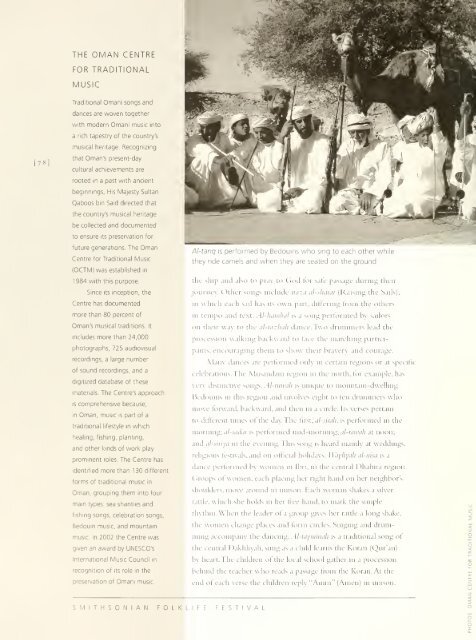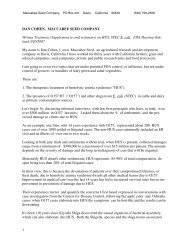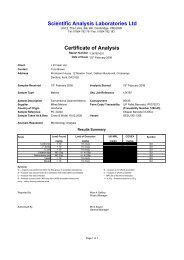Smithsonian - Perishable Pundit
Smithsonian - Perishable Pundit
Smithsonian - Perishable Pundit
Create successful ePaper yourself
Turn your PDF publications into a flip-book with our unique Google optimized e-Paper software.
THE OMAN CENTREFOR TRADITIONALMUSICTraditional Omani songs anddances are woven togetherwith modern Omani music intoa rich tapestry of the country'smusical heritage. Recognizing[78]that Oman's present-daycultural achievements arerooted in a past with ancientbeginnings, His Majesty SultanQaboos bin Said directed thatthe country's musical heritagebe collected and documentedto ensure its preservation forfuture generations. The OmanCentre for Traditional MusicAl-tanq is performed by Bedouins who sing to each other whilethey ride camels and when they are seated on the ground.(OCTM) was established in1984 with this purpose.the ship and also to pray to God for sate passage during theirSince its inception, thejourney. Other songs include nasa al-sharal(Raising the Sails),Centre has documentedmore than 80 percent ofOman's musical traditions. Itincludes more than 24,000photographs, 725 audiovisualrecordings, a large numberof sound recordings, and adigitized database of thesematerials. The Centre's approachiscomprehensive because,in Oman, music is part of atraditional lifestyle in whichhealing, fishing, planting,and other kinds of work playprominent roles. The Centre hasidentified more than 130 differentforms of traditional music inOman, grouping them into fourmain types: sea shanties andfishing songs, celebration songs,Bedouin music, and mountainmusic. In 2002 the Centre wasgiven an award by UNESCO'sInternational Music Council inrecognition of its role in thein which each sail has its own part, differing from the othersin tempo and text. Al-hambal is a song performed by sailorson their way to the al-razhah dance. Two drummers lead theprocession walking backward to face the marching participants,encouraging them to show then bravery and courage.Many dances are performed only m certain regions or at specificcelebrations. The Musandam region m the north, tor example, hasven distinctive songs. Al-nnvah is unique to mountain-dwellingBedouins in this region and involves eight to ten drummers whomove forward, backward, and then m a circle. Its verses pertainto different times of the day. The first, al-sirah, is performed in themorning; al-sadai is performed mid-morning; al-rawah at noon:and al-siriya m the evening. This song is heard mainly at weddings,religious festivals, and on official holidays. Wayliyah al-nisa is adance performed by women inIbri, m the central Dhahira region.Groups of women, each placing her right hand on her neighbor'sshoulders, move around in unison. Each woman shakes a silverrattle, which she holds in her tree hand, to mark the simplerh\ thm. When the leader of a group gives her rattle a long shake,the women change places .\nd form circles. Singing and drummingaccompany the dancing. Al-tayminah is a traditional song ofthe central Dakhliyah, sung as a child learns the Koran (Qur'an)by heart. The children of the local school gather m a processionbehind the teacher who reads a passage from the Koran. At thepreservation of Omani music.end of each verse the children reply "Amin" (Amen) inunison.SMITHSONIAN FOLKLIFE FESTIVAL








